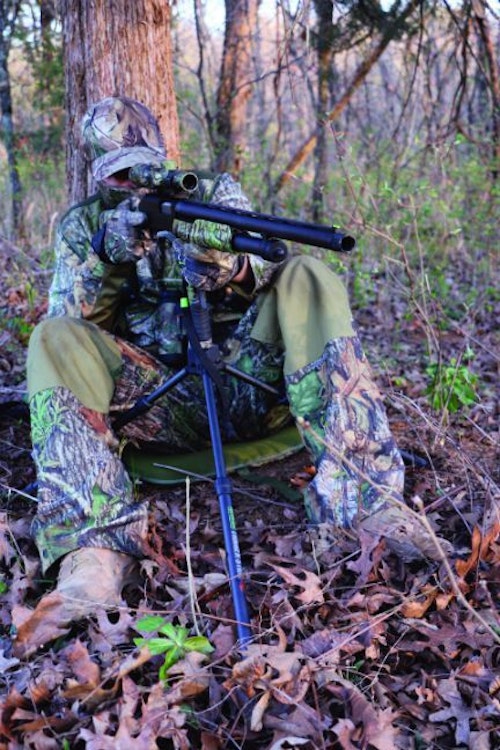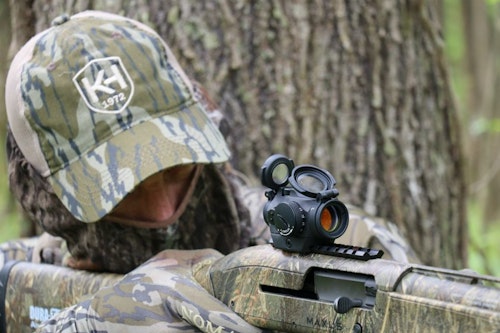Years ago, before the nationwide spring gobbler boom took hold, the idea of a turkey shotgun was straightforward. Typically, it was a worn 12-gauge pump that doubled as a duck, pheasant, small-game and, with Foster-style slugs, deer gun.
That concept has faded. Nowadays, gobbler hunters insist on using turkey-specific shotguns designed and accessorized solely for the spring game. Manufacturers and retailers have responded, offering uncountable models intended for one function: to put beards and spurs on the wall and turkey breasts in the fryer.
Cynical observers contend that multi-purpose shotguns performed admirably for turkey hunting, and that worn pump would work just as well today as it did when your granddad shot his first longbeard. But let’s admit that several tweaks can turn that all-around gun into a more refined and effective gobbler slayer. Here’s a look at some firearm features and accessories modern turkey hunters demand.
Aftermarket Chokes
With the advent of heavy-payload turkey-specific loads (see the sidebar), hunters want high-performance choke tubes that produce optimum patterning performance. That makes sense, as turkey nuts obsess about putting the maximum number of pellets in a 10-inch circle or a turkey’s head and neck at previously unheard-of ranges. Hunters who want to turn multi-purpose shotguns into high-functioning turkey slayers can usually do so just by upgrading a gun’s choke.
Many factory tubes produce good patterns, but CNC-machined aftermarket models typically perform better. Popular designs typically have extremely tight constrictions, such as .655 for lead shot in 12-gauges or somewhat looser models (say .675) for heavier-than-lead 12-gauge loads. Ultra-tight aftermarket chokes, combined with many heavier-than-lead shotshell offerings, have also spawned new interest in shooting sub-gauges — even .410s — for turkeys.
The tight-choke trend has created a Catch-22 in tube selection. Often, customers assume any tight choke will mesh perfectly with their gun and load. That’s not always true. A choke that’s too tight for a gun and ammo can produce inconsistent patterns with many holes and flyers. One that’s too loose won’t optimize patterns.
Finding the right choke depends on many factors, including ammunition, a gun’s bore (some 12-gauges have larger bores, such as .745, instead of the standard .729 constriction, for example) and the intangibles involved in matching a specific gun, ammunition and choke into a pattern-crushing team. Unfortunately for consumers, the only way to discover the best combination is to test several chokes and loads with a gun. Generally, tighter chokes work best with smaller shot, such as No. 6 lead, and looser models perform better with larger shot, such as No. 4s. Heavier-than-lead shot often calls for somewhat looser constrictions.
Hunters also wonder whether they should buy ported or non-ported tubes. Ported tubes reduce muzzle jump and separate the wad from the shot faster, often improving patterns. Still, the only true determinant is how a choke performs with a specific gun and load. Customers should experiment with ported and non-ported tubes to see what best fits their setup.
Sights
Firing ultra-tight patterns from a scattergun is more like shooting a rifle than a standard shotgun. Centering the payload on a gobbler’s vitals demands precision, which often requires a sight. Initially, turkey hunters outfitted guns with scopes or iron-type sights. Today, most prefer red-dots or other electronic aids.
These can run the gamut, from relatively inexpensive dot-style models to high-performance devices that can break the bank. The bottom line is that any electronic sight must be reliable and durable. It should mount firmly to the gun — using a rail is often wise — so it doesn’t get knocked off center when dragged through brush or mud. A hood or similar shield helps protect the sight from rain and grime.
Further, an electronic sight should have long battery life. Adjustable brightness and dot size also prove handy. You don’t need a red-dot glowing at full power in the dim early morning light. Conversely, you’re at a disadvantage with a dull, small aim point during bright sunlight.
Above all, a hunter must be comfortable shooting with a specific sight. As with chokes, they can only establish that by checking out several models and identifying one they like.

Sling
Turkey hunters realized early that a sling makes long days afield easier. Toting a shotgun by hand across hardwood ridges or endless mesquite flats can wear you out.
Many sling styles work. Simple models that wrap around a gun’s barrel and grip can temporarily turn a multi-purpose gun into a comfortable spring setup. Many dedicated turkey shotguns feature sling swivels attachments for permanent attachment.
Sling preference is personal, but many turkey guys like padded models that lesson perceived weight on your shoulder. Also, slings that grip your shoulder well and won’t slip make for easier and safer gun transportation. And of course, many folks want camouflaged slings that match their shotguns or apparel.
Camo or Dull Finish
With apologies to the many great modern camo patterns, turkey guns really don’t need a custom camouflage finish. At a minimum, parkerized or black-matte-finished models reduce glare and perform well afield. However, many turkey nuts want guns with baked-on camo finishes that match hunting clothing or make a fashion statement. Manufacturers offer many such models, and all modern patterns look great. Customers should at least choose camouflage guns that best match their hunting backgrounds — dark, muted tones for timber, or lighter grass- or leaf-highlighted patterns for open spaces.
Short Barrels
Years ago, someone determined that shorter shotgun barrels let hunters move through the woods easier and adjust their guns more seamlessly without catching on undergrowth or bumping against trees. Such barrels also reduce weight somewhat for folks who love to run and gun.
Turkey-gun barrel length boils down to comfort. Many hunters prefer common 24-inch turkey-specific barrels. Some go shorter, and others are content with 26-inch models. The only shooting consideration involves how a barrel performs with a shotgun, choke and load, and again, experimentation determines that.
Recoil Reduction
Light turkey guns and heavy loads demand recoil-reducing features. Often, hunters are comfortable with stout recoil pads, including slip-on models for all-around guns. Other folks prefer more expensive higher-tech recoil-softening designs available from some manufacturers. The choice depends on your chosen load and recoil tolerance.
The Best Turkey Gun
Ultimately, hunting style and a hunter’s love of gadgetry determine how many accessories they demand on a turkey gun. However, the features mentioned here can turn almost any shotgun into a high-performance turkey-styled model. Having multiple options available can help customers make informed choices and let you become a turkey hunter’s No. 1 retail option.

What’s Hot in Turkey Ammo
Once known only to a few reloading geeks, Tungsten Super Shot now dominates the turkey ammo scene.
It’s easy to see why. With a density of 18 grams per cubic centimeter, TSS is almost twice as dense as lead (11 grams per cubic centimeter) and also tops other tungsten-based nontoxics. The super-heavy pellets let shell-makers create pellet-packed loads of tiny shot that produce the same energy as much larger shot but considerably boost pattern density. For example, No. 9 TSS shot carries about the same downrange energy and penetration as No. 4 lead shot fired at the same muzzle velocity. However, because the 9s are much smaller than 5s, the TSS load will have a far higher pellet count than the lead shell. One ounce of TSS has about 360 pellets, compared to about 135 pellets in 1 ounce of No. 4 lead. A 2-ounce 12-gauge load of No. 9 TSS holds about 450 more pellets than a 2-ounce load of lead No. 4s.
Further, because of the performance even relatively small loads of the shot provide, TSS has prompted new interest in sub-gauge turkey hunting, with many folks using 28-gauge and even .410-bore guns.
Manufacturers have taken notice. Federal offers several 12-gauge, 20-gauge and .410 TSS turkey loads, including some with blended loads that combine Nos. 7 and 9 or 8 and 10 TSS shot. Likewise, Browning has several 12- and 20-gauge TSS loads of Nos. 7 and 9 shot, plus .410 bore in No. 9 shot. Remington offers Premier TSS shotshells in 12-gauge, 20-gauge and .410, and Apex Ammunition produces several TSS loads in many gauges.
Five Must-Stock Turkey Guns
Benelli Performance Shop M2 Turkey: This 20-gauge has a lengthened forcing cone, enlarged bolt handle and custom bolt-release lever for easy operation. It’s fitted with a ComforTech buttstock, with AirTouch checkering on the buttstock and forend for a sure grip. Plus, it features Benelli’s Inertia Driven operating system.
Browning BPS NWTF: This 12-gauge combines BPS reliability with durable Hi-Vis 4-in-1 sights and three Invector-Plus choke tubes. Sporting a 24-inch barrel, the shotgun comes in Mossy Oak Break-Up Country with an NWTF buttstock decal.
Mossberg 500 Field .410: With proven Mossberg pump-action reliability, this new .410 is designed for sub-gauge turkey hunters. It has a 26-inch barrel, dual extractors, twin action bars and an anti-jam elevator for smooth operation. Available in Mossy Oak Bottomland.
Remington V3 Turkey Pro: Featuring Remington’s Versa Port gas system, this shotgun combines reliability with soft recoil into a sleek platform. It comes with a Truglo Headbanger choke tube and a 40-yard factory-bore-sighted Truglo optic and is adorned in Realtree Timber.
Weatherby SA-459 Turkey Xtra Green: The 459’s 22-inch barrel and rubberized pistol grip let turkey hunters get on target quickly. A green fiber-optic bead provides steady aim, and an extra-full fluted choke tube delivers tight, consistent patterns. The gun also features a dual valve gas system and chrome-lined bore.






